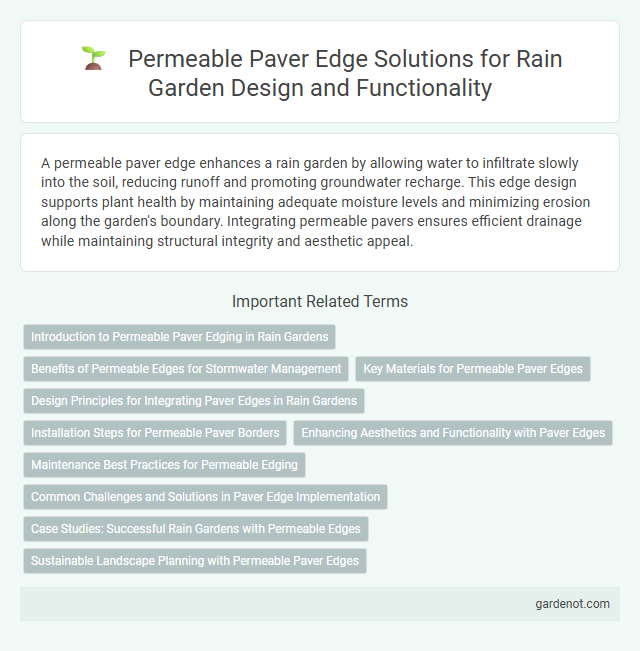A permeable paver edge enhances a rain garden by allowing water to infiltrate slowly into the soil, reducing runoff and promoting groundwater recharge. This edge design supports plant health by maintaining adequate moisture levels and minimizing erosion along the garden's boundary. Integrating permeable pavers ensures efficient drainage while maintaining structural integrity and aesthetic appeal.
Introduction to Permeable Paver Edging in Rain Gardens
Permeable paver edging in rain gardens enhances water infiltration by allowing stormwater to pass through the surface while providing structural support to garden beds. These pavers reduce runoff and promote groundwater recharge, making them essential for sustainable rain garden design. Integrating permeable paver edges improves drainage efficiency and minimizes soil erosion around rain garden perimeters.
Benefits of Permeable Edges for Stormwater Management
Permeable paver edges effectively reduce stormwater runoff by allowing water to infiltrate the soil, thus decreasing surface flooding and erosion. These edges enhance groundwater recharge while filtering pollutants, improving water quality before it reaches natural water bodies. Their design supports sustainable stormwater management by promoting natural hydrological cycles in urban landscapes.
Key Materials for Permeable Paver Edges
Key materials for permeable paver edges include concrete, natural stone, and recycled plastic, each offering durability and effective water infiltration. Concrete pavers provide structural integrity while allowing stormwater to seep through joint spaces, minimizing runoff. Recycled plastic edging enhances sustainability and flexibility, maintaining edge stability without compromising permeability.
Design Principles for Integrating Paver Edges in Rain Gardens
Permeable paver edges in rain gardens enhance water infiltration by allowing runoff to pass through gaps between pavers, reducing surface water accumulation and promoting groundwater recharge. Design principles prioritize selecting paver materials with sufficient void space, ensuring proper slope and grading to guide water flow into planting areas, and incorporating stable, permeable bedding layers to maintain structural integrity while facilitating drainage. Integrating these elements supports sustainable stormwater management and prevents erosion along garden edges.
Installation Steps for Permeable Paver Borders
To install permeable paver borders for a rain garden, begin by excavating the designated edge area to a depth of 6 to 8 inches, ensuring proper slope for water runoff management. Next, lay a geotextile fabric to prevent soil migration, followed by a base layer of compacted gravel or crushed stone to enhance drainage. Finally, place the permeable pavers tightly along the edge, filling joints with permeable aggregate to maintain water infiltration and structural stability.
Enhancing Aesthetics and Functionality with Paver Edges
Permeable paver edges enhance rain garden aesthetics by providing clean, defined borders that complement natural landscaping. These paver edges improve functionality by allowing efficient water infiltration, reducing runoff and promoting groundwater recharge. Durable materials and customizable designs ensure both visual appeal and long-term performance in sustainable garden environments.
Maintenance Best Practices for Permeable Edging
Maintaining permeable paver edges in rain gardens involves regular debris removal to prevent clogging and ensure proper water infiltration. Inspections should be conducted seasonally to check for soil erosion or displacement of pavers, which can compromise drainage efficiency. Applying a layer of joint sand or polymeric sand helps stabilize the edges and reduces weed growth, enhancing the longevity of the permeable edging system.
Common Challenges and Solutions in Paver Edge Implementation
Common challenges in permeable paver edge implementation include soil erosion, misalignment, and inadequate drainage, which can compromise the rain garden's effectiveness. Solutions involve installing proper geotextile fabrics to stabilize the soil, using edge restraints like metal or polymer edging to prevent shifting, and ensuring the paver system integrates with subsurface drainage to maintain permeability. Regular inspection and maintenance help address sediment buildup and organic debris that can reduce infiltration rates.
Case Studies: Successful Rain Gardens with Permeable Edges
Case studies of rain gardens incorporating permeable paver edges demonstrate significant improvements in stormwater management and groundwater recharge. Projects in urban areas like Portland and Seattle reveal that permeable paver edges reduce surface runoff by up to 40% while enhancing soil infiltration rates. These successful implementations also show increased pollutant filtration, supporting healthier ecosystems and sustainable urban landscapes.
Sustainable Landscape Planning with Permeable Paver Edges
Permeable paver edges enhance sustainable landscape planning by allowing efficient stormwater infiltration and reducing runoff. These pavers support groundwater recharge and minimize soil erosion, contributing to healthier local ecosystems. Integrating permeable edges within rain gardens promotes water conservation and mitigates urban flooding through natural filtration processes.
Permeable paver edge Infographic

 gardenot.com
gardenot.com